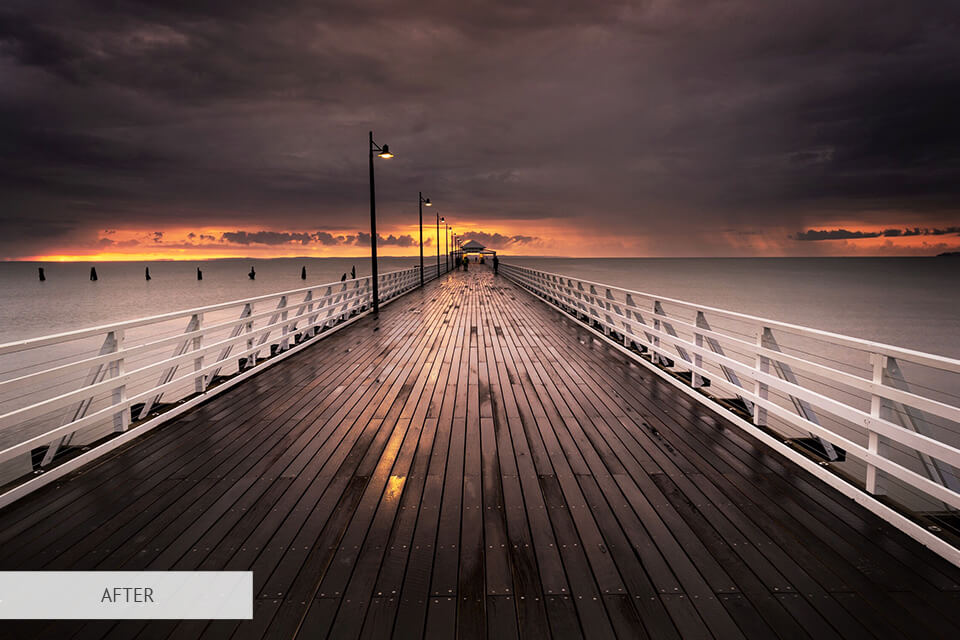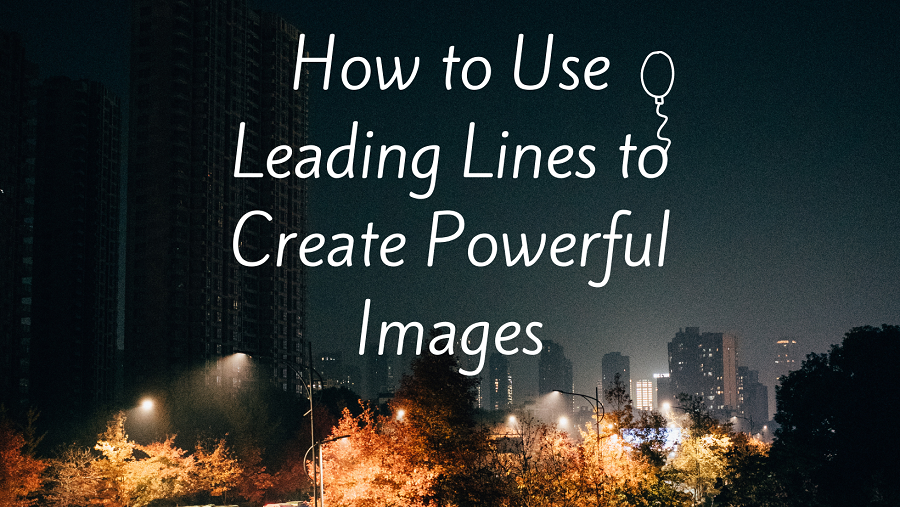Leading lines are an effective way to create powerful and dynamic
images that
capture the viewer's attention. By using
natural or man-made lines in your composition, you can guide the viewer's eye toward your subject, create a sense of movement, and add depth to your
images. In this guide, we'll explore different types of leading lines, including diagonal lines, curved lines, and perspective, and provide
tips on how to use them to
create impactful and memorable
photographs.We'll also cover the importance of paying attention to composition, keeping it simple, and experimenting with different
techniques to find your own unique style. Whether you're a beginner or an experienced
photographer, understanding how to use leading lines can take your
photography to the next level and help you create
images that truly stand out.
Leading lines are one of the most effective compositional
techniques in
photography, used to draw the viewer's attention toward a particular part of an
image. Leading lines are lines or shapes within an
image that lead the viewer's eye toward a specific point of interest. Here are some tips on how to use leading lines to create powerful images:
-
When looking for natural lines, start by observing your surroundings and paying attention to the lines and shapes that are present. Look for lines that lead the eye toward a point of interest, such as a tree, building, or person. Some examples of natural lines include:
- A road or path that leads towards a building or other point of interest.
- A river or stream that flows towards a particular area.
- The outline of a mountain range in the distance.
- The branches of a tree lead toward a particular point.
- The lines on a leaf or flower lead toward the center.
Remember that the lines don't have to be straight or obvious to be effective. Sometimes, more subtle or abstract lines can create an interesting and dynamic composition. Look for shapes, patterns, and textures that can create lines or lead the viewer's eye toward your subject. With practice, you'll start to see natural lines and shapes everywhere and be able to use them to create powerful and impactful images. -
Diagonal lines are a powerful compositional tool in photography that can add a sense of movement and dynamism to an image. They create a feeling of energy and can add a sense of direction or flow to the image. Here are some tips on how to use diagonal lines effectively in your photographs:
- Look for diagonal lines in your environment: Diagonal lines can be found in a variety of objects, such as bridges, staircases, and roads. Look for lines that naturally lead the viewer's eye toward your subject.
- Use the rule of thirds: Position your subject at an intersection of the imaginary gridlines that divide the image into thirds. This will create a dynamic composition that draws the viewer's eye toward your subject.
- Experiment with angles: Try shooting from different angles to create diagonal lines that lead toward your subject. Shooting from a low angle can create more dramatic diagonal lines while shooting from a high angle can create a more subtle effect.
- Use negative space: Negative space refers to the empty space in an image that surrounds the subject. By placing your subject off-center and using negative space to create diagonal lines, you can create a more dynamic composition.
- Use converging lines: Converging diagonal lines can add depth and dimension to your image. Look for lines that converge towards a point in the distance and position your subject at the vanishing point.
Remember that diagonal lines don't have to be straight or obvious to be effective. Sometimes, more subtle or abstract lines can create an interesting and dynamic composition. With practice, you'll start to see diagonal lines everywhere and be able to use them to create powerful and impactful images. -
Curved lines can be a powerful compositional tool in photography. They can add a sense of movement, flow, and grace to your images. Here are some tips on how to use curved lines effectively in your photos:
- Look for natural curves: Curved lines can be found in a variety of objects in nature, such as trees, flowers, and rivers. Look for lines that naturally lead the viewer's eye toward your subject.
- Use leading lines: Curved lines can also be used as leading lines that draw the viewer's eye toward your subject. Position your subject at the end of the curve to create a more dynamic composition.
- Use symmetry: Curved lines can be used to create symmetry in your images. Position your subject at the center of the curve to create a balanced composition.
- Experiment with different types of curves: Curves can be subtle or dramatic, smooth or jagged. Experiment with different types of curves to create the mood and feeling that you want in your images.
- Use negative space: Negative space can be used to create curved lines that lead toward your subject. Place your subject off-center and use negative space to create a curved line that leads the viewer's eye toward your subject.
Remember that curved lines don't have to be obvious to be effective. Sometimes, more subtle or abstract lines can create an interesting and dynamic composition. With practice, you'll start to see curved lines everywhere and be able to use them to create powerful and impactful images. -
Experimenting with perspective is a great way to create powerful and dynamic images that capture the viewer's attention. Here are some tips on how to use perspective to create impactful images:
- Use a wide-angle lens: A wide-angle lens can help to exaggerate perspective and create a sense of depth in your images. Use a wide-angle lens to capture more of the scene and create a more immersive experience for the viewer.
- Shoot from a low angle: Shooting from a low angle can create a sense of drama and power in your images. It can also help to exaggerate the perspective and make your subject appear larger than life.
- Use a shallow depth of field: A shallow depth of field can be used to create a sense of depth in your images by blurring the background and emphasizing the subject. This can help to create a more immersive and dynamic image.
- Experiment with symmetry: Symmetry can be used to create a sense of balance and harmony in your images. Experiment with different types of symmetry, such as reflection or repetition, to create a more impactful composition.
- Play with scale: Changing the scale of your subject in relation to the surrounding environment can create a sense of drama and impact. Try placing a small subject in a large environment or a large subject in a small environment to create a more dynamic composition.
Remember that perspective is a creative tool, and there are no hard and fast rules. Experiment with different techniques and find what works best for your style and vision. With practice, you'll be able to use perspective to create powerful and impactful images that capture the viewer's attention. -
Composition is one of the most important aspects of photography. A well-composed image can capture the viewer's attention and convey a powerful message. Here are some tips on how to pay attention to composition in your photographs:
- Use the rule of thirds: The rule of thirds is a basic principle of composition that involves dividing your image into thirds, both vertically and horizontally. Place your subject along one of these imaginary lines or at the intersection of the lines to create a more dynamic and balanced composition.
- Pay attention to balance: Balance is important in composition to create a sense of harmony and order in your images. Balance can be achieved by placing your subject off-center and using negative space to balance the composition.
- Use leading lines: Leading lines can be used to guide the viewer's eye toward your subject and create a sense of movement and depth in your images. Look for natural or man-made lines, such as roads or bridges, that can be used as leading lines.
- Experiment with framing: Framing can be used to create a sense of context and depth in your images. Use natural elements, such as trees or archways, to frame your subject and create a more interesting composition.
- Simplify your composition: Sometimes less is more in photography. Simplifying your composition by removing distractions and focusing on the main subject can create a more impactful image.
Remember that composition is subjective and there are no hard and fast rules. Experiment with different techniques and find what works best for your style and vision. With practice, you'll be able to use composition to create powerful and impactful images that capture the viewer's attention. Keep it simple:
Keeping it simple is an important principle in photography. A simple and uncluttered image can be more powerful and impactful than a complex and busy one. Here are some tips on how to keep it simple in your photographs:- Focus on one subject: Focusing on one subject can help to simplify your composition and create a clear focal point for the viewer.
- Use negative space: Negative space can be used to simplify your composition and draw attention to your subject. Use negative space to create a more minimalist and uncluttered image.
- Avoid distractions: Distractions, such as bright colors or busy backgrounds, can take away from the impact of your subject. Be mindful of your surroundings and avoid anything that could distract from your main subject.
- Use a simple color palette: A simple color palette can help to create a more cohesive and harmonious image. Use colors that complement each other and avoid using too many contrasting colors.
- Eliminate unnecessary elements: Eliminate any unnecessary elements in your composition that do not add to the story or message of your image.
Remember that simplicity is subjective and there are no hard and fast rules. Experiment with different techniques and find what works best for your style and vision. With practice, you'll be able to use simplicity to create powerful and impactful images that capture the viewer's attention.
FAQ:
What are the leading lines in photography?Leading lines are natural or man-made lines that are used to guide the viewer's eye toward a specific point in the image, such as the main subject or focal point. They can be used to create a sense of depth and movement in the image, and to add visual interest and impact.
What types of leading lines can be used in photography?There are many types of leading lines that can be used in photography, including diagonal lines, curved lines, horizontal lines, vertical lines, and perspective lines.
How can diagonal lines be used as leading lines?Diagonal lines can create a sense of movement and dynamism in the image. They can be used to lead the viewer's eye toward the main subject and to create a more dynamic and impactful composition.
How can curved lines be used as leading lines?Curved lines can add a sense of flow and grace to an image. They can be used to create a sense of movement and to guide the viewer's eye toward the main subject.
How can perspective be used as a leading line?Perspective lines can create a sense of depth and dimension in an image. They can be used to lead the viewer's eye toward the main subject and to create a more immersive and impactful composition.
What is the importance of composition in using leading lines?Composition is important in using leading lines to create powerful images. A well-composed image can capture the viewer's attention and convey a powerful message. Using the rule of thirds, paying attention to balance, and keeping it simple can help to create a more impactful and memorable image.
How can I experiment with using leading lines in my photography?Experimentation is key to finding your own unique style when using leading lines in photography. Try using different types of leading lines, angles, and perspectives to create a more dynamic and impactful composition. Don't be afraid to try new things and push the boundaries of your creativity.
Conclusion:
In conclusion, using leading lines is a powerful technique in photography that can help create impactful and memorable images. By using natural or man-made lines, such as diagonal lines, curved lines, and perspective lines, you can guide the viewer's eye toward your main subject, create a sense of movement and depth, and add visual interest to your images.Paying attention to composition, keeping it simple, and experimenting with different techniques can help you find your own unique style and create images that truly stand out. Whether you're a beginner or an experienced photographer, understanding how to use leading lines can help take your photography to the next level and help you create images that capture the viewer's attention and imagination.



 admin
admin








